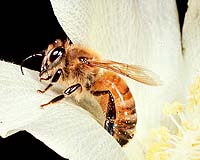 |
San Francisco CA (SPX) Jan 20, 2010 Scientists have mapped the genomes for three kinds of parasitic wasps, providing a new genetic model system based on the Nasonia genus. The availability of these genome sequences will aid the analysis of complex genetic traits, such as skin color, as well as complex human diseases. Published in the Jan. 15 issue of Science, the findings may help advance our understanding of how to use these wasps as natural agents against agricultural pests and disease-carrying insects. "These genome sequences will be a major tool for agricultural pest control," said Chris Smith, assistant professor of biology at San Francisco State University and one of the study's authors. "Many people may not realize how dependent humans are on these tiny wasps which protect our food crops and save the U.S. billions of dollars each year by reducing crop loss." An international consortium of scientists mapped the complete DNA sequences for three species in the Nasonia genus, a group of tiny parasitic wasps that are a quarter of the size of a fruit fly. The wasps lay their eggs on other insects, which then hatch and kill the host creature. Wasps in the Nasonia genus are particularly suited to genetic research because the males develop from unfertilized eggs. Since they only have one copy of each gene, scientists can immediately see the effects of mutant genes, while in most species the second copy of the gene can hide problems in a mutant gene.
Share This Article With Planet Earth
Related Links San Francisco State University Farming Today - Suppliers and Technology
 Making a buzz: French roads to help honey bees
Making a buzz: French roads to help honey beesParis (AFP) Jan 19, 2010 France is to sow nectar-bearing flowers on the sides of roads in an experiment aimed at helping the honey bee, hit by an alarming worldwide decline, the ministry of sustainable development said on Tuesday. More than 250 kilometres (155 miles) of roadside will be sown in the coming months, launching a three-year test that could be extended to the country's 12,000-kilometer (7,500-mile) networ ... read more |
|
| The content herein, unless otherwise known to be public domain, are Copyright 1995-2009 - SpaceDaily. AFP and UPI Wire Stories are copyright Agence France-Presse and United Press International. ESA Portal Reports are copyright European Space Agency. All NASA sourced material is public domain. Additional copyrights may apply in whole or part to other bona fide parties. Advertising does not imply endorsement,agreement or approval of any opinions, statements or information provided by SpaceDaily on any Web page published or hosted by SpaceDaily. Privacy Statement |